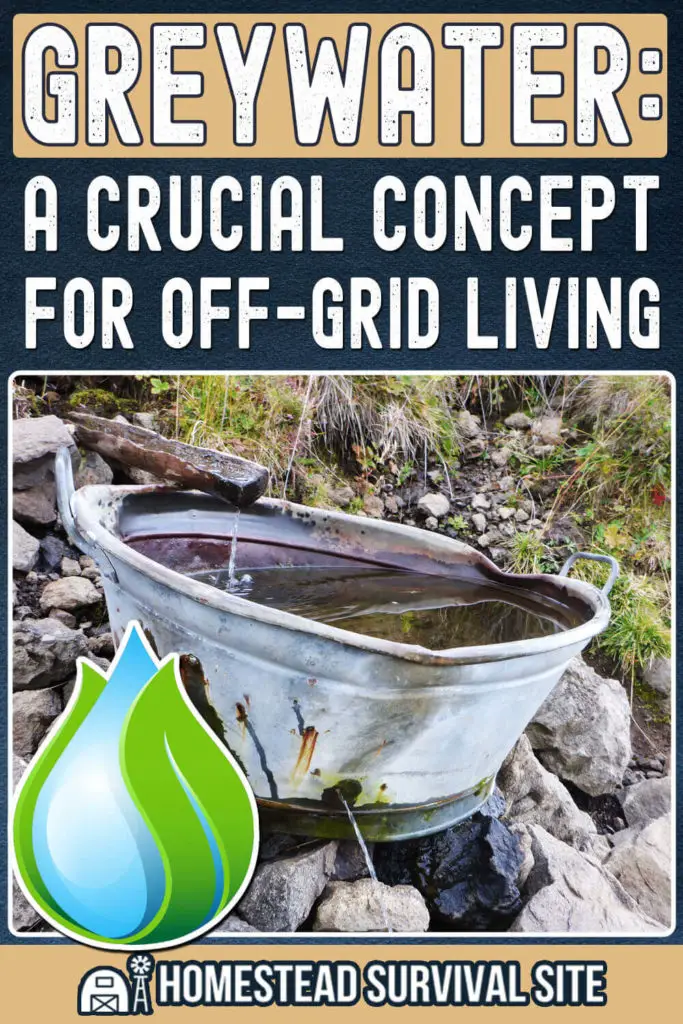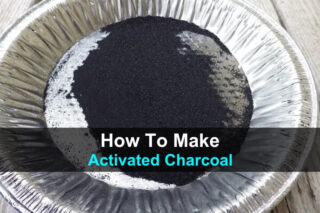Estimated reading time: 6 minutes
When you live off the grid, you realize how many aspects of modern life you took for granted. One of them is having an abundant supply of clean water at the turn of a handle.
However, as much of the world faces the challenges of drought conditions, if you're living or planning to live off-grid, you must think about ways to cut down on water usage and re-purpose some of what you do use.
According to the United States Geological Survey, the average American uses between 80 and 100 gallons of water every day for drinking, cooking, toilet flushing, bathing, and lawn and garden care. In most cases, all that water is potable water.
One of the best ways to reclaim some of the water that literally runs down the drain is through the use of greywater.
Want to save this post for later? Click Here to Pin It On Pinterest!
What is Greywater?
Greywater is the minimally contaminated wastewater from your bathroom sinks, showers, tubs, dishwashers, and laundry machines. It differs from the toxic “blackwater” that comes from the toilet or from washing diapers.
Greywater comprises 50 to 80 percent of most household wastewater. Recycling greywater is legal in many states, especially in the West where it is often encouraged as a way to help conserve water. However, it is important to check with local authorities before installing a greywater system.
Uses for Greywater
Greywater is suitable for irrigating most lawns and gardens, including fruit trees and ornamental beds. Since this lightly-used wastewater usually contains phosphorous and nitrogen nutrients, it can be an excellent good source of nourishment for your soil.
Unlike rainwater, greywater is available every time you take a bath or do your laundry. However, it should not be used on the portion of a vegetable that you eat, including root vegetables such as carrots, radishes, and potatoes.
Another important use for greywater is to flush toilets. Using potable water for this purpose can waste 1.28 to 1.6 gallons of water per flush in newer toilets and a whopping five to seven gallons per flush in older models.
How to Harness Greywater
You can try some easy, low-tech ways to harness greywater, and you can take some more complicated steps.
The easiest way to reclaim some wasted clean water is to catch the water in your shower that is wasted while you wait for it to warm up. You can store these buckets in the bathroom and use them to refill the tank when you flush the toilet. Or you can carry them outside to water your plants.
Another firmly simple step is to divert the water exiting your washing machine with a valve that directs the wastewater into a drum outside your home. With the use of a tube or a spigot near the bottom of the drum, you can channel this reclaimed to water in the garden.
Similarly, you can set up systems that divert water from the shower and bathroom sink.
A third greywater system involves integrating your home's plumbing into a greywater collection system. These systems usually connect bathroom, kitchen, and laundry drains to a system that moves the greywater to a collection tank.
Some systems have an emergency shut-off switch that ensures there will be no backflow into the home's main freshwater pipes. These greywater systems are susceptible to blockage due to soap, hair, and grease, so they do require regular maintenance.
The cost of a more complex greywater system depends on the size of your home and property. Expenses include installation, materials (valves, pipes, and other components), filter, holding tank, and, in some cases, a pump to get the water where you want it to go if gravity is not in your favor.
Greywater Guidelines and Benefits
While greywater may appear a bit cloudy and dirty, it is safe and even beneficial for many uses around the home and garden. However, here are some important rules to follow when using greywater.
- Do not store greywater for more than 24 hours. After a day or so, the nutrients will begin to break down and emit an unpleasant odor.
- Keep physical contact minimal with greywater. Greywater is not safe for people or animals to drink.
- If you regularly water your plants with greywater, rinse them occasionally with rainwater to remove any built-up residue.
- Avoid allowing greywater to pool, puddle, or run off. Use it when and where it can soak into the ground since stagnant greywater can become a mosquito breeding ground or otherwise become an unhealthy location.
- Avoid detergents and soaps that contain bleach, boron, sodium, artificial dyes, synthetic fragrances, and preservatives such as phenoxyethanol and polyethylene glycol.
Aside from the obvious benefits of saving water and the money you spend on freshwater, recycling greywater in the garden keeps it out of your sewer or septic system, reducing the chance that it will pollute local water bodies.
Here Are Some Other Benefits
- Water conservation. Many regions are experiencing record drought conditions. Households that use greywater are helping combat this crisis.
- Reduced chemical usage. When you use greywater, less water is going to a sewage treatment plant or your septic system. This practice reduces the need for the chemicals that maintain the system.
- Less fertilizer usage. Since greywater contains nutrients, you will need to purchase and use less fertilizer to keep your soil healthy.
- Enhanced groundwater supply. Greywater used in the garden is filtered by the soil as it moves down to lower levels of the ground. As it replenishes the soil levels, it helps rebuild the underground water supply that is necessary for local waterways.
It doesn't make sense to use gallons of freshwater to flush a toilet or to throw gently used water down the drain. If you'd like more information on greywater and how you can use it in your home and property, here are some resources we found:
- Greywater, Green Landscape: How to Install Simple Water-Saving Irrigation Systems in Your Yard by Laura Allen
- The Water-Wise Home by Laura Allen
- Builder's Greywater Guide by Art Ludwig
- The New Create an Oasis with Greywater by Art Ludwig
Like this post? Don't Forget to Pin It On Pinterest!











